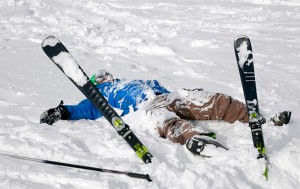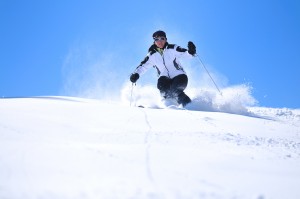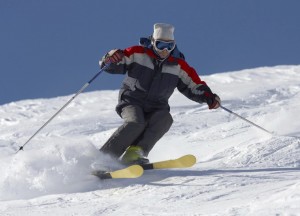 Nestled between the base of the Alps and Munich and squared off by France, Austria and the Czech Republic is the little town of Törwang, Germany in Upper Bavaria, where my father grew up.
Nestled between the base of the Alps and Munich and squared off by France, Austria and the Czech Republic is the little town of Törwang, Germany in Upper Bavaria, where my father grew up.
Green, sunny and with the Alps looming overhead, my dad’s youth was filled with snow and skiing during the winter months. He’d tell me stories of whisking down the hill to school on his new wooden skis he painstakingly rubbed to make them look used (in those days, having brand spanking new skis was not cool).
Other stories told of wiping out on a mountain, tumbling far down to the bottom, colliding with his sister yet both miraculously okay despite the non-giving leather straps that still held the skis on his feet.
For my father, skiing wasn’t a sport, but just a way of life.
These days sports loom big and skiing has grown by leaps into the future with technology leading the way for not just speed and comfort, but safety as well. Still, even the most high tech equipment can’t prevent accidents from happening on the slopes.
Orthopedic Surgeon, Dr. Andrew Bulczynski of DISCSports & SpineCenter in Newport Beach shares common-sense tips to help prevent injury whether you are an avid skier or thrusting snowboarder.
skier or thrusting snowboarder.
Most people hit the slopes with little to no preparation which can result in injury or worse. Dr. Bulczyniski who works regularly with Red Bull athletes explains, “Whether you’re a first-timer, weekend warrior or elite athlete, everyone can use a refresher when approaching a new ski season.”
He makes some very valid points. Tuning up your gear at the beginning of every season assures everything fits. Well-fitted gear – helmet, boots, boards, skis and poles – allows for comfort that helps performance and decreases injury risk.
Along with tuned gear, tune up the body. Strong, well-toned muscles double as good shock absorbers for the body. By keeping them in good shape, the reward is a smooth ride down the mountain. Fuel your engine well in advance, giving the body proper nourishment with a healthy diet.
Eating right is an important component of every fitness plan and every day performance. Here is an important one and usually dismissed: warm it up. Proper warm-up consists of any low-impact cardio activity of your choice for about a few minutes so the heart starts pumping and its rate increases. Push-ups, jumping jacks, or a light jog while waiting for friends are some of the simple ways needed to get the body ready for the slopes.
 Snow is highly reflective, almost doubling the UV exposure and reaching the skin from different angles, so use sunscreen regardless of the weather. Overcast days can result in some of the worst burns. Be sure to apply and reapply throughout the day.
Snow is highly reflective, almost doubling the UV exposure and reaching the skin from different angles, so use sunscreen regardless of the weather. Overcast days can result in some of the worst burns. Be sure to apply and reapply throughout the day.
Stay hydrated. For a full day of snowboarding or skiing, the body requires a substantial amount of water. If you feel thirsty, you are already behind. Fluid requirements vary amongst individuals depending on fitness level, gender, body type, activity and environmental conditions.
To make it easy, try wearing a water bladder backpack so water is available at all times. When using ski poles, bring the hand through the loop from below upwards, then grasp the grip. This helps avoid a wrist injury such as a fracture.
Stretching after a warm up and any athletic activity is more effective and decreases the likelihood of injury since warm muscles and tendons become supple and respond better to stretching.
Applying these tips can go a long way for insuring fun and exercise on the slopes without the discomfort of injuries.
Contact Gina at Ima_gina_tion@yahoo.com.




